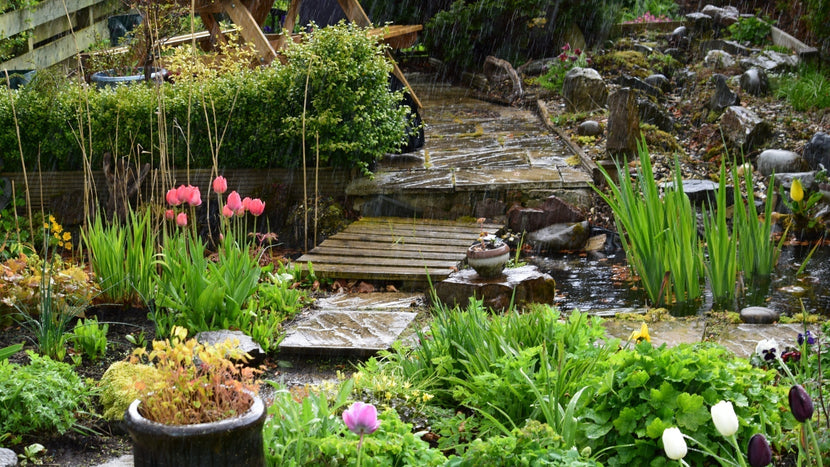
Rain Gardens: How to Fight Flooding & Pollution — & Help Pollinators
Rain gardens are more than just a pretty addition to your landscape—they’re a powerful tool for managing stormwater, improving water quality, and supporting pollinator populations. Designed to collect and absorb rainwater runoff from roofs, driveways, and other hard surfaces, rain gardens help reduce localized flooding, filter pollutants from stormwater, and provide a thriving habitat for beneficial insects.
With climate change causing more frequent heavy rain events, incorporating a rain garden into your yard is a smart, sustainable solution that blends beauty with purpose.

What Is a Rain Garden?
A rain garden is a shallow, bowl-shaped planting bed strategically located to capture runoff from impervious surfaces. Unlike a traditional garden bed, a rain garden is designed with amended soil that allows water to slowly infiltrate into the ground instead of running off into storm drains.
Native plants with deep root systems are typically used because they’re well adapted to local climates, improve soil structure, and support native wildlife, especially bees, butterflies, and other pollinators.
How Rain Gardens Reduce Flooding and Pollution
During heavy rain, stormwater runoff often carries pollutants like fertilizers, oil, pesticides, and sediment into local waterways. Rain gardens act as a natural filtration system, capturing this runoff and allowing the soil and plants to clean the water before it seeps into the ground.
This not only helps reduce the strain on municipal drainage systems but also helps replenish groundwater and reduce erosion. By slowing the flow of water, rain gardens prevent the sudden surge of runoff that contributes to flash flooding and stream bank damage.

Pollinator Paradise: A Biodiverse Bonus
While their primary role is stormwater management, rain gardens also offer a valuable opportunity to support pollinators. Many of the best plants for rain gardens—such as Joe Pye Weed, Blue Flag Iris, Lobelia cardinalis, Milkweed, and Purple Coneflower—are native perennials that produce nectar-rich blooms.
These plants attract and sustain pollinators like native bees, butterflies, hummingbirds, and beneficial insects. By choosing a variety of species that bloom from spring through fall, you can ensure your rain garden supports pollinators all season long.
Best Plant Choices for Rain Gardens
When designing a rain garden, it’s important to include a mix of plants that thrive at different moisture levels—from the wettest zone in the center to the drier outer edges. A successful planting combines deep-rooted native perennials, ornamental grasses, and structural shrubs to absorb water, stabilize soil, and support pollinators and wildlife. Here are some excellent, low-maintenance, pollinator-friendly options:
For the basin (wettest area):

These plants tolerate standing water and periodic flooding.
Lobelia cardinalis (Cardinal Flower) – attracts hummingbirds with bold red blooms
Iris versicolor (Blue Flag Iris) – colorful and ideal for saturated soils
Chelone glabra (White Turtlehead) – host plant for Baltimore checkerspot butterfly
Cephalanthus occidentalis ‘Sugar Shack’ (Buttonbush) – native shrub with spherical flowers loved by butterflies and bees
For mid-slopes (moist to average conditions):
These plants can handle fluctuating moisture and are great for filling the middle zones.
Eupatorium Gateway (Joe Pye Weed) – tall, nectar-rich blooms for butterflies
Asclepias incarnata (Swamp Milkweed) – essential monarch host plant
Monarda fistulosa (Wild Bergamot) – aromatic foliage and bee-attracting flowers
Liatris Kobold (Gay Feather) – upright blooms that naturalize well
Itea virginica ‘Little Henry’ (Virginia Sweetspire) – deciduous shrub with fragrant flowers and brilliant fall color
Clethra alnifolia Hummingbird’ (Summersweet Clethra) – shrub with fragrant blooms that attract bees and hummingbirds
For the edges (drier zones):

These plants prefer well-drained soil and give structure to the perimeter of the rain garden.
Echinacea purpurea ‘Magnus’ (Purple Coneflower) – long-blooming pollinator favorite
Rudbeckia fulgida (Black-eyed Susan) – low-maintenance and full of summer color
Schizachyrium scoparium ‘ Standing Ovation’ (Little Bluestem) – native grass with upright habit and winter interest
Solidago Fireworks (Goldenrod) – late-season blooms for migrating pollinators
Aronia melanocarpa (Black Chokeberry) – compact native shrub with white spring flowers, fall foliage, and wildlife-friendly berries
Lindera benzoin (Spicebush) – host plant for spicebush swallowtail butterflies and great for woodland edges
With the right mix of native perennials, grasses, and shrubs, your rain garden will manage stormwater efficiently, support biodiversity, attract pollinators, and provide year-round beauty and habitat. Choose plants that bloom in succession for continuous color and forage from spring through fall.
Tips for Creating Your Own Rain Garden
1. Choose the Right Location
Site your rain garden at least 10 feet away from your home’s foundation to avoid water seepage and in a spot that naturally collects water.
2. Amend the Soil
Mix compost and sand with your native soil to improve drainage and help with pollutant filtration.
3. Select Native Plants
Choose deep-rooted, flood-tolerant natives that can handle both wet and dry conditions.
4. Mulch and Maintain
Use shredded hardwood mulch to reduce weed growth and help retain moisture. Water plants during the first growing season and weed regularly to keep your garden thriving.
A Smart Step Toward Sustainability
Rain gardens are a win-win for homeowners and the environment. They reduce flooding, improve water quality, and create vibrant, low-maintenance habitats for pollinators and wildlife.
Whether you live in the suburbs or in a city, a well-designed rain garden is a beautiful and practical way to make your landscape more resilient and eco-friendly. With just a little planning, you can transform a problem area in your yard into a powerful tool for conservation and biodiversity.
